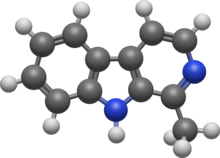
| |

| |
| Names | |
|---|---|
| Preferred IUPAC name
1-Methyl-9H-pyrido[3,4-b]indole | |
| Other names
Harman, Aribine, Aribin, Locuturine, Locuturin, Loturine, Passiflorin, 1-Methylnorharman, NSC 54439
| |
| Identifiers | |
3D model (JSmol)
|
|
| ChEBI | |
| ChemSpider | |
| ECHA InfoCard | 100.006.948 |
| EC Number |
|
| KEGG | |
PubChem CID
|
|
| UNII | |
CompTox Dashboard (EPA)
|
|
| |
| |
| Properties | |
| C12H10N2 | |
| Molar mass | 182.226 g·mol−1 |
| Melting point | 235–238 °C (455–460 °F; 508–511 K) |
| Soluble to 10 mM in 1 eq. HCl
methanol: soluble 50 mg/ml | |
Except where otherwise noted, data are given for materials in their standard state (at 25 °C [77 °F], 100 kPa).
| |
Harmane (harman) is a heterocyclic amine found in a variety of foods including coffee,[1] sauces,[2] and cooked meat.[3] It is also present in tobacco smoke.[4]
Harmane is related to other alkaloids, harmine and harmaline, found in 1837 in the plant Peganum harmala.[5] The name derives from the Arabic word for the plant, حَرْمَل (ḥarmal).
In humans, harmane is a potent tremor-producing neurotoxin.[6] Harmane has been found to inhibit the early stages of the growth of the malaria parasite in the gut of mosquitoes infected by the bacterium Delftia tsuruhatensis, and can be absorbed by the mosquitoes upon contact.[7][8][9]
- ^ Herraiz, T; Chaparro, C (2006). "Human monoamine oxidase enzyme inhibition by coffee and beta-carbolines norharman and harman isolated from coffee". Life Sciences. 78 (8): 795–802. doi:10.1016/j.lfs.2005.05.074. PMID 16139309.
- ^ Herraiz, T. (2004). "Relative exposure toβ-carbolines norharman and harman from foods and tobacco smoke". Food Additives and Contaminants. 21 (11): 1041–50. doi:10.1080/02652030400019844. PMID 15764332. S2CID 216644379.
- ^ Louis, E. D.; Zheng, W; Jiang, W; Bogen, K. T.; Keating, G. A. (2007). "Quantification of the neurotoxic beta-carboline harmane in barbecued/grilled meat samples and correlation with level of doneness". Journal of Toxicology and Environmental Health, Part A. 70 (12): 1014–9. Bibcode:2007JTEHA..70.1014L. doi:10.1080/15287390601172015. PMC 4993204. PMID 17497412.
- ^ Herraiz, Tomas; Chaparro, Carolina (2005). "Human monoamine oxidase is inhibited by tobacco smoke: β-carboline alkaloids act as potent and reversible inhibitors". Biochemical and Biophysical Research Communications. 326 (2): 378–86. doi:10.1016/j.bbrc.2004.11.033. PMID 15582589.
- ^ Claude Lotfi (1967). "Contribution à l'étude du Peganum harmala (L.) (Hermel)".
- ^ Louis, Elan D; Jiang, Wendy; Pellegrino, Kathryn M; Rios, Eileen; Factor-Litvak, Pam; Henchcliffe, Claire; Zheng, Wei (2008). "Elevated blood harmane (1-methyl-9H-pyrido[3,4-b]indole) concentrations in essential tremor". Neurotoxicology. 29 (2): 294–300. doi:10.1016/j.neuro.2007.12.001. PMC 2291546. PMID 18242711.
- ^ Huang, Wei; Rodrigues, Janneth; Bilgo, Etienne; Tormo, José R.; Challenger, Joseph D.; De Cozar-Gallardo, Cristina; Pérez-Victoria, Ignacio; Reyes, Fernando; Castañeda-Casado, Pablo; Gnambani, Edounou Jacques; Hien, Domonbabele François de Sales; Konkobo, Maurice; Urones, Beatriz; Coppens, Isabelle; Mendoza-Losana, Alfonso (2023-08-04). "Delftia tsuruhatensis TC1 symbiont suppresses malaria transmission by anopheline mosquitoes". Science. 381 (6657): 533–540. Bibcode:2023Sci...381..533H. doi:10.1126/science.adf8141. hdl:10044/1/105278. ISSN 0036-8075. PMID 37535741. S2CID 260440907.
- ^ Offord, Catherine (3 August 2023). "Microbe stops mosquitoes from harboring malaria parasite". Science.
- ^ Naomi Grimley (Aug 4, 2023). "Chance discovery helps fight against malaria". BBC.